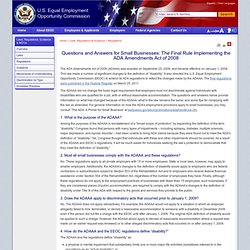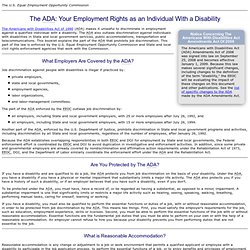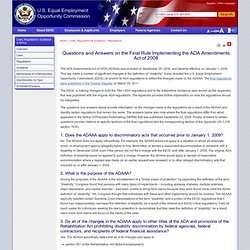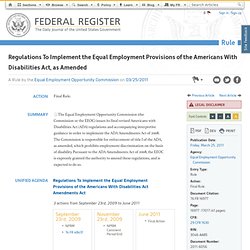Zoom
Trash

Highlights of the Final Rule to Amend the Department of Justice's Regulation Implementing Title II of the ADA. Questions and Answers for Small Businesses: The Final Rule Implementing the ADA Amendments Act of 2008. The ADA Amendments Act of 2008 (ADAAA) was enacted on September 25, 2008, and became effective on January 1, 2009.

This law made a number of significant changes to the definition of “disability.” It also directed the U.S. Equal Employment Opportunity Commission (EEOC) to amend its ADA regulations to reflect the changes made by the ADAAA. The final regulations were published in the Federal Register on March 25, 2011. The ADAAA did not change the basic legal requirement that employers must not discriminate against individuals with disabilities who are qualified for a job, with or without reasonable accommodation. 1. Among the purposes of the ADAAA is reinstatement of a “broad scope of protection” by expanding the definition of the term “disability.” 2. No. 3. ADA - Your Employment Rights as an Individual With a Disability. The U.S.

Equal Employment Opportunity Commission The Americans with Disabilities Act (ADA) Amendments Act of 2008 was signed into law on September 25, 2008 and becomes effective January 1, 2009. Because this law makes several significant changes, including changes to the definition of the term "disability," the EEOC will be evaluating the impact of these changes on this document and other publications. See the list of specific changes to the ADA made by the ADA Amendments Act. The Americans with Disabilities Act of 1990 (ADA) makes it unlawful to discriminate in employment against a qualified individual with a disability. What Employers Are Covered by the ADA? Job discrimination against people with disabilities is illegal if practiced by: private employers, state and local governments, employment agencies, labor organizations, and labor-management committees.
The part of the ADA enforced by the EEOC outlaws job discrimination by: Fact Sheet on the EEOC’s Final Regulations Implementing the ADAAA. Questions and Answers on the Final Rule Implementing the ADA Amendments Act of 2008. The ADA Amendments Act of 2008 (ADAAA) was enacted on September 25, 2008, and became effective on January 1, 2009.

This law made a number of significant changes to the definition of “disability.” It also directed the U.S. Equal Employment Opportunity Commission (EEOC) to amend its ADA regulations to reflect the changes made by the ADAAA. The final regulations were published in the Federal Register on March 25, 2011. The EEOC is making changes to both the Title I ADA regulations and to the Interpretive Guidance (also known as the Appendix) that was published with the original ADA regulations. The questions and answers below provide information on the changes made to the regulations as a result of the ADAAA and identify certain regulations that remain the same. Regulations To Implement the Equal Employment Provisions of the Americans With Disabilities Act, as Amended. A.

Revise paragraphs (g) through (m). b. In paragraph (o)(1)(ii), remove the words “a qualified individual with a disability” and add, in their place, “an individual with a disability who is qualified”. c. In paragraph (o)(3), remove the words “the qualified individual with a disability” and add, in their place, “the individual with a disability”. d. (g) Definition of “disability.” (1) In general. (i) A physical or mental impairment that substantially limits one or more of the major life activities of such individual; (ii) A record of such an impairment; or (iii) Being regarded as having such an impairment as described in paragraph (l) of this section.
. (2) An individual may establish coverage under any one or more of these three prongs of the definition of disability, i.e., paragraphs (g)(1)(i) (the “actual disability” prong), (g)(1)(ii) (the “record of” prong), and/or (g)(1)(iii) (the “regarded as” prong) of this section. Note to paragraph (g): See§ 1630.3 for exceptions to this definition.